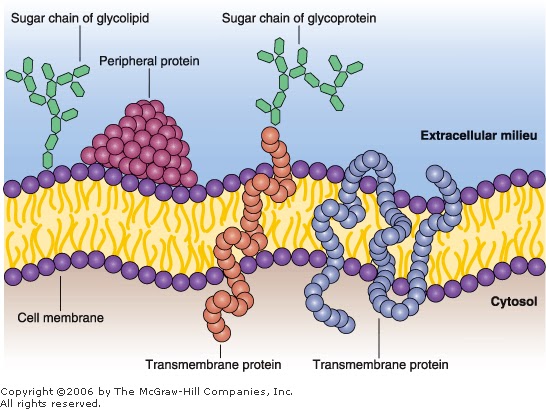Phagocytosis literally means "cell eating" and can be compared to pinocytosis, which means "cell drinking." Certain cell types, such as macrophages and polymorphonuclear leukocytes, are specialized for incorporating and removing foreign bacteria, protozoa, fungi, damaged cells, and unneeded extracellular constituents. For example, after a bacterium becomes bound to the surface of a macrophage, cytoplasmic processes of the macrophage are extended and ultimately surround the bacterium. The edges of these processes fuse, enclosing the bacterium in an intracellular phagosome.
Exocytosis is the term used to describe the fusion of a membrane-limited structure with the plasma membrane, resulting in the release of its contents into the extracellular space without compromising the integrity of the plasma membrane. A typical example is the release of stored products from secretory cells, such as those of the exocrine pancreas and the salivary glands (Figure 4–27). The fusion of membranes in exocytosis is a complex process. Because cell membranes exhibit a high density of negative charges (phosphate residues of the phospholipids), membrane-covered structures coming close to each other will not fuse but will rather repel each other, unless specific interactions facilitate the fusion process. Consequently, exocytosis is mediated by a number of specific fusogenic proteins. Usually, Ca2+ regulates the process. An increase in cytosolic Ca2+ often triggers exocytosis.
During endocytosis, portions of the cell membrane become an endocytotic vesicle; during exocytosis, the membrane is returned to the cell surface. This phenomenon is called membrane trafficking (Figures 2–7 and 2–8). In several systems, membranes are conserved and reused several times during repeated cycles of endocytosis.
Repost...
Figure 2-7 & Figure 2-8
References
| Afzelius BA, Eliasson R: Flagellar mutants in man: on the heterogeneity of the immotile-cilia syndrome. J Ultrastruct Res 1979;69:43. [PMID: 501788] |
| Aridor M, Balch WE: Integration of endoplasmic reticulum signaling in health and disease. Nat Med 1999;5:745. [PMID: 10395318] |
| Barrit GJ: Communication Within Animal Cells. Oxford University Press, 1992. |
| Becker WM et al: The World of the Cell, 4th ed. Benjamin/Cummings, 2000. |
| Bretscher MS: The molecules of the cell membrane. Sci Am 1985;253:100. [PMID: 2416050] |
| Brinkley BR: Microtubule organizing centers. Annu Rev Cell Biol 1985;1:145. [PMID: 3916316] |
| Brown MS et al: Recycling receptors: the round-trip itinerary of migrant membrane proteins. Cell 1983;32:663. [PMID: 6299572] |
| Cooper GM: The Cell: A Molecular Approach. ASM Press/Sinauer Associates, Inc., 1997. |
| DeDuve C: A Guided Tour of the Living Cell. Freeman, 1984. |
| DeDuve C: Microbodies in the living cell. Sci Am 1983;248:74. |
| Dustin P: Microtubules, 2nd ed. Springer-Verlag, 1984. |
| Farquhar MG: Progress in unraveling pathways of Golgi traffic. Annu Rev Cell Biol 1985;1:447. [PMID: 3916320] |
| Fawcett D: The Cell, 2nd ed. Saunders, 1981. |
| Krstíc RV: Ultrastructure of the Mammalian Cell. Springer-Verlag, 1979. |
| Mitchison TJ, Cramer LP: Actin-based cell motility and cell locomotion. Cell 1996;84:371. [PMID: 8608590] |
| Osborn M, Weber K: Intermediate filaments: cell-type-specific markers in differentiation and pathology. Cell 1982;31:303. [PMID: 6891619] |
| Pfeffer SR, Rothman JE: Biosynthetic protein transport and sorting in the endoplasmic reticulum. Annu Rev Biochem 1987;56:829. [PMID: 3304148] |
| Rothman J: The compartmental organization of the Golgi apparatus. Sci Am 1985;253:74. [PMID: 3929377] |
| Simons K, Ikonen E: How cells handle cholesterol. Science 2000;290:1721. [PMID: 11099405] |
| Tzagoloff A: Mitochondria. Plenum, 1982. |
| Weber K, Osborn M: The molecules of the cell matrix. Sci Am 1985;253:110. [PMID: 4071030] |
|



















1 comments:
fagositosis...termasuk transpor aktif ya... XI
Posting Komentar